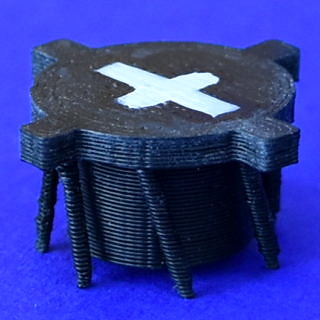Seven-legged ‘beetles’ simulate dust clouds

FAU physicists confirm theory of particle movement in granular gases
Physicists at FAU have managed to make a major contribution that will aid research into avalanches, sand storms and cosmic dust clouds. By means of an innovative experiment in which autorotating particles, so-called vibrots, were used, they have been able to confirm the theory of particle dynamics in granular systems. The results have now been published in the eminent journal Physical Review Letters.*
The clouds of very fine particles that form avalanches and sand storms behave similarly to molecular gases. The particles are in constant motion, collide randomly and exchange energy in the process. Unlike gas molecules, however, such collisions are not elastic, so that the solid particles lose kinetic energy each time they collide until they finally come to a halt.
At the same time there are particles that continue to move at high speed within the granular cloud, as they have not yet collided. ‘This difference in the speed of movement of a large number of particles with low kinetic energy and a small number of high-energy particles cannot be adequately described using the standard kinetic gas theory,’ says Prof. Dr. Thorsten Pöschel of the Chair of Multiscale Simulation of Particulate Systems at FAU.
Previous experiments revealed weaknesses in the theory
Two decades ago, researchers developed a model based on the kinetic gas theory that describes the special speed distribution in granular gases. This model was confirmed by numerous mathematical simulations, but obtaining experimental proof has been difficult so far. ‘The most promising concept developed to date was to put granular particles such as metal or plastic pellets in motion using a vibration table with a rough surface,’ explains Thorsten Pöschel.
‘However, the basic problem here is that the collisions do not take place as randomly as would be the case in a molecular gas.”
The solution: rotating particles
The physicists in Erlangen have now found a way around this problem. They also use a vibration table, but the energy is initially converted into a rotational movement. For this purpose, the team used a 3D printer to produce so-called vibrots – small, beetle-shaped plastic elements with seven inclined legs. The incline of the legs ensures that the rotational speed of the particles changes randomly each time they jump.
All vibrots rotate clockwise, but at different speeds, averaging approximately six rotations per second. When two vibrots collide, the rotation energy is converted into a linear movement. Thorsten Pöschel and his FAU colleague, Dr. Christian Scholz, positioned several hundred vibrots on a vibration table and found that the resultant movements occurred randomly, as there were no significant correlations.
Theory confirmed for granular gases
By means of this experiment, the researchers were able to confirm the dynamic theory of granular gases. Across much of the low-speed range averaging 20 millimetres per second, the vibrots behaved a way similar to that of gas molecules. However, there were significantly more particles with a high speed of over 60 millimetres per second than would have been expected in a molecular gas. The speed distribution profile of the vibrots conformed to the predictions of the kinetic gas theory.
The confirmation of the kinetic model of granular gases is important both for application-oriented research, such as the study of avalanches and the particle clouds generated by industrial processes, and for theoretical research, such as investigations of cosmic dust.
*The results of the experiments have published in an article entitled ‘Velocity Distribution of a Homogeneous Driven Two-Dimensional Granular Gas’ in the leading journal Physical Review Letters. doi:10.1103/PhysRevLett.118.198003
More information:
Prof. Thorsten Pöschel
Phone: +49 9131 8520865